Adaptive Reuse of the Seagram Barrel Warehouses in Waterloo
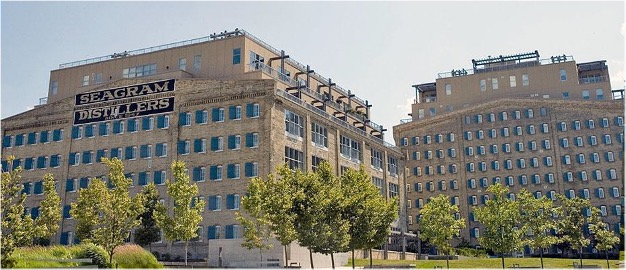
Case Study prepared by Anjelica Asika, Carleton University.
Keywords: Industrial Heritage, Adaptive Reuse, Waterloo, Sustainable Development, Housing
- Lessons Learned
- Description
- Timeline
- Rightsholders and Stakeholders
- Heritage
- Sustainability
- Assessment and Measurement
- Works Cited
LESSONS LEARNED
The adaptive reuse of the Seagram Barrel Warehouses provided the City of Waterloo with a revitalization of one of the community’s leading industries. As a unique part of the City’s heritage that has been magnificently transformed into urban loft living, the buildings are an example of living history and have raised the bar for reurbanization in the City of Waterloo.
A key to success of the Seagram Barrel Warehouses conversion was the dedication of both the City of Waterloo and the developers, Barrel Works Group Ltd, as well as the interest of the public. The City of Waterloo council was unanimously in favour of the project and its redevelopment. With a project such as Seagram Lofts, with its high upfront costs and profitability that is more difficult to achieve, the support of the municipality is fundamental to success. The developer said: “Waterloo has invested in the downtown area. There is a lot of political will and staff support…and the City readily provided assistance that was absolutely necessary for this type of project.” The City offered incentives, such as waiving development charges, free road and utility infrastructure and assistance with environmental concerns (Canada Mortgage and Housing Corporation).
When embarking on a project of this size and stature, the political and economic environment has to be suitable to achieve success. Shared visions and goals between the developer and the municipality are key elements in a necessary partnership. Unique projects like Seagram Lofts are financially risky, but also rewarding for the community and reputation-building (Canada Mortgage and Housing Corporation). The transformation of the warehouses into lofts demonstrates the possibilities of adaptive reuse and how buildings can be tweaked in order to serve a new purpose.
PRESENTATION SHC Case Study Presentation – Anjelica Asika
The attached presentation offers a summary of the case study’s key points. It highlights important information pertaining to the project including an origin and timeline, the stakeholders and rights holders involved in the project, sustainability efforts and many more factors. It was presented in class on November 28th, 2024
DESCRIPTION
The Seagram Barrel Warehouses are located at 3 and 5 Father David Bauer Drive in Waterloo, Ontario. Now known as the Seagram Lofts, the former warehouses once housed thousands of whisky barrels on wooden racks for the Seagram Distillery. Seagram Lofts is an adaptive reuse of a brownfield site which created residential property in the heart of Waterloo’s downtown core (Canada Mortgage and Housing Corporation).
In 1857, settlers William Hespeler and George Randall gave this approximately eleven acre piece of land its first European name; Granite Mills and Waterloo Distillery. The focus of their business was operating a flour mill, grinding grains, mainly wheat, into flour. Making whisky with the leftover grains was only a small part of their business. In 1883, second-generation British immigrant Joseph E. Seagram purchased the company, renaming it ‘The Joseph Seagram Flour Mill and Distillery Company.’ Under Seagram’s leadership, the company ceased its flour mill operations and focused entirely on whisky. Seagram skilfully began combining and blending different types of grains to create complex flavours for whisky. These new rich flavours produced in Waterloo gained worldwide attention, creating a demand for the young distiller’s products (City of Waterloo Museum). Following a decade of decline in the distilling industry, the distillery closed its doors in 1992. At its peak in the 1970s, the Seagram complex provided regular employment to as many as 250 local citizens.
Built in the early 1900s, the two warehouses, which exist now as the Seagram Lofts, served an important purpose for the company. The structures could hold five to seven thousand wooden barrels for ageing whisky, with a typical 40-gallon barrel weighing up to 550 pounds. The charred, white oak barrels influenced the flavour and colour of the product. As the barrels expanded during warm weather and contracted in the cold, the whisky would enter in and out of the oak pores, infusing the flavor of oak into the whisky. The windows on the warehouses, which are still a prominent feature of the buildings today, were necessary at the time for ventilation. During warmer weather, whisky vapours would concentrate on the upper floors, occasionally leaving workers intoxicated, to some extent, from the concentrations (Waterloo Heritage).
After a fire in 1993 destroyed all but a few buildings, the City of Waterloo purchased the Seagram property in 1997. To encourage redevelopment, the City put out a ‘request for proposals’ enticing developers to present ideas for the two buildings. Terra View Homes and Kiwi Newton joined to form Barrel Works Group Ltd and were awarded the contract to turn the warehouses into condominiums (Waterloo Heritage). The community was thrilled by this new venture and by January of 1999, phase one was 70% sold. Waterloo residents got their first look at this new vision later in April when the first model suite was completed. After much work, residents began to move into the newly transformed building in the fall of 1999. The project cost 24 million dollars and after two and a half years of construction, the lofts were completed in 2001 (City of Waterloo Museum).
The Seagram Lofts have become a new part of Waterloo’s history. The buildings together have a total of 103 two-storey loft units with high ceilings which are a mix of residential and live-work units. In addition to this, they also feature rooftop gardens. In 2016, the former Seagram Barrel Warehouses were designated under the Ontario Heritage Act. The Seagram Lofts are a spectacular example of adaptive re-use with historic elements complimenting the new, creating a truly unique building.
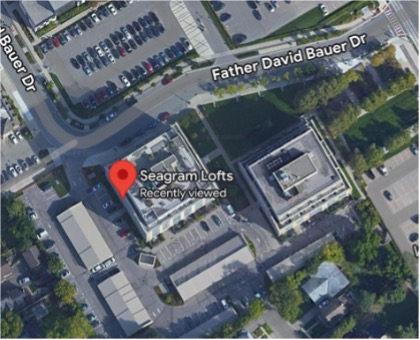
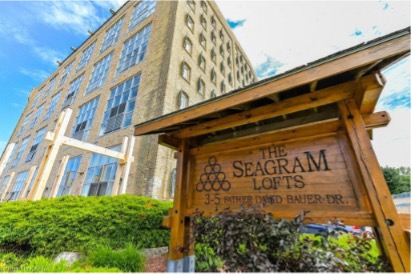
https://rachdave.com/real-estate-properties/property-details/1667153/5-father-david-bauer-drive-unit-305-waterloo-o ntario/
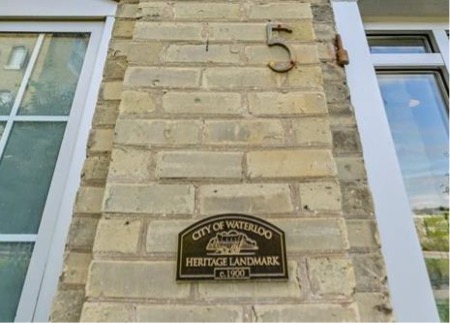
https://rachdave.com/real-estate-properties/property-details/1667153/5-father-david-bauer-drive-unit-305-waterloo-o ntario/
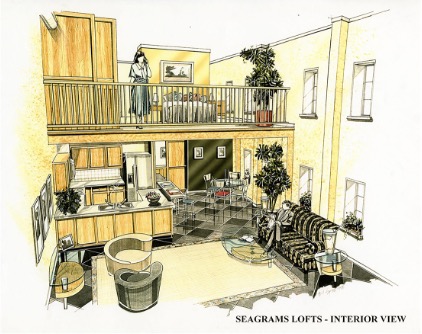
TIMELINE
| DATE | EVENT |
| 1857 | Seagram Distillery begins operations (Waterloo Heritage). |
| 1883 | Under ownership of Joseph E. Seagram, the company ceased its flour mill operations and focused entirely on whisky (Waterloo Heritage). |
| 1892 | The Seagram Barrel Warehouses are constructed (Waterloo Chronicle). |
| 1928 | The distillery has had much success, importing internationally and becoming the largest producer of spirits (City of Waterloo Museum). |
| 1992 | The distillery closes following a decade of decline in the distilling industry (Waterloo Heritage). |
| 1993 | A fire destroys all but a few of the Seagram buildings (Waterloo Heritage). |
| 1997 | The City of Waterloo purchased the Seagram property for $3.95million and put out a ‘request for proposals’ for developers to present ideas for the barrel warehouses (Waterloo Heritage). |
| 1998 | Terra View Homes and Kiwi Newton Construction, joined to form Barrel Works Group Ltd., were awarded the contract to turn the warehouses into residential loft condominiums (Waterloo Heritage). |
| 2000 | Received the Best Project of the Year Award from the Waterloo Region Home Builders’ Association. |
| 2001 | The construction of the lofts is completed with 103 units (Waterloo Heritage). |
| 2016 | Waterloo council votes unanimously to designate the former Seagram Barrel Warehouses under the Ontario Heritage Act (Waterloo Chronicle). |
RIGHTSHOLDERS AND STAKEHOLDERS
Indigenous Peoples: The adaptive reuse of the Seagram Lofts must be contextualized within its location on the Haldimand Tract, traditional and unceded territory of the Anishinaabe, Haudenosaunee and Neutral Peoples. Despite the Six Nations title to the land granted in 1784, European settlers began encroaching on and acquiring land through colonial processes that disregarded Indigenous governance and land rights (Independent Living Waterloo Region; City of Waterloo Museum). The transformation of these warehouses represents not only an architectural and community achievement but also an opportunity to reflect on land stewardship, acknowledge Indigenous histories and engage with Indigenous communities.
Government Entities and Agencies
- The City of Waterloo: The central authority overseeing the project. Played an active role in the saving of the Seagram Barrel Warehouses and put out requests for redevelopment proposals (Waterloo Heritage).
- Ontario Heritage Trust: This is an agency of the Government of Ontario. They played a key role in the designation of the property under the Ontario Heritage Act (Ontario Heritage Trust).
- Other involved entities include the Waterloo Region Home Builders’ Association.
Consultants and Contractors
- Barrel Works Group Ltd: The major developers and contractors of the project. They purchased the property from The City of Waterloo and redeveloped the site to produce the mixed-use residential ‘lofty living’.
- Architectural and engineering firms including Janet Rosenberg & Studio (Landscape Architects), L. Alan Grinham Architect Inc, Wendy Shearer Landscape Architect and Sze Straka Engineers Ltd.
- Wilson Blanchard Management: Responsible for the management of the lofts.
Local Communities: The public i.e. the Waterloo community and residents: The neighbourhood was able to comment on the development through open houses and community consultations. This enabled the community to be involved and subsequently lead to their endorsement of the plan (Canada Mortgage and Housing Corporation).
HERITAGE
Indigenous Heritage: The Waterloo region is located on the Haldimand Tract, traditional and unceded territory of the Anishinaabe, Haudenosaunee and Neutral Peoples. It encompasses 980,000 acres of land that was given to the Six Nations in 1784, ten kilometers on each side of the Grand River. This land is part of the Dish with One Spoon Treaty between the Haudenosaunee and Anishnaabe Peoples and symbolizes the agreement to share, protect resources, and not to engage in conflict. (Independent Living Waterloo Region). Despite having title to the land, a European way of understanding land, new settlers began encroaching on the six miles of the Grand River. Through a series of events, a group of Mennonite settlers acquired their land under the name The German Company. This marked a change with the introduction of European presence on the land (City of Waterloo Museum).
Cultural Heritage: The buildings have direct association with historic personalities and vital industrial developments that are significant to the community. The Seagrams played important roles in the history of Waterloo as industrialists, politicians and philanthropists. From 1857 to 1992, the distillery operated continuously in the heart of Waterloo. As one of the community’s leading industries, the Seagram complex provided regular employment to as many as 250 local citizens. Although the family is no longer in the alcohol distilling business, the Seagram name is known around the world. The buildings serve as a landmark and icon in the City of Waterloo appearing on tourist promotion brochures, letterheads, postcards and websites (Ontario Heritage Trust). The repurposing of the warehouses into lofts reflects the cultural shift towards valuing heritage preservation and adaptive reuse, aligning historical heritage with modern day urban needs. Johanna Botari, condo owner and a board member for 3 Father David Bauer said residents support the designation as a way to get their voices heard on developments happening around them and related issues. “We’d just like to see it as a way to have our concerns noted at the beginning rather than try to address things once they have happened,” she said. The designation is to conserve significant exterior features and some views of the buildings’ east and north facades from Caroline Street (Waterloo Region Record). In 2016, the former warehouses were designated as places of cultural heritage value under the Ontario Heritage Act.
Industrial Heritage: The Seagram Distillery was founded in 1857 as the Waterloo Distillery by William Hespeler, a merchant from Kitchener, and George Randall, a contractor for the Grand Trunk Railway. The former warehouses possess a unique and rare industrial architectural style evident in its neoclassical form, low pitched pediment, buff brick and distinctive fenestration. Their original function, the storage of whisky barrels, is also demonstrated through a variety of architectural elements, such as the rows of small shuttered windows used for ventilating fumes that accumulated during the whisky storage and aging process. The Seagram buildings are historically and visually linked to their surroundings as the barrel warehouses define the historic industrial character of the city as a manufacturing powerhouse of the 19th and 20th centuries (Waterloo Government; Commercial, Industrial and Retail Landscapes). Even after its closure in 1992, the distillery’s redevelopment into the Seagram Lofts has revitalized the local economy by attracting residents. Plant closures and modernization of the distilling industry have resulted in the demolition of all but a few of these old warehouses. Waterloo may be one of the only places in Ontario where you can find as many as three of them (Waterloo Heritage).

Credits: Waterloo Heritage, https://waterlooheritage.com/2017/04/05/seagram-lofts-viewshed/
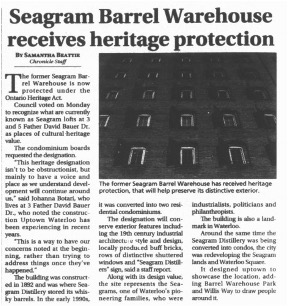
SUSTAINABILITY
Environmental sustainability: The Seagram Lofts project was a challenge that was welcomed by the developers. Transforming old warehouses of this scale into attractive residential units is a monumental task, especially when trying to save only portions of the existing structure. The developer made great efforts to reuse much of the original brick and barrel-wood salvaged during selective demolition. This allowed the developer to retain the look and feel of the warehouses while actually creating almost brand-new buildings (Canada Mortgage and Housing Corporation). Reclaimed bricks, for example, were used to build new exterior walls, parking garages and for interior finishes. Similarly, reclaimed timber from the original racking was milled onsite and repurposed for doors, window casings, trim, stairs, railings, parking garages etc. Amazingly, all bricks and timber on site are original – no new bricks or timber were purchased. The extensive repurposing of materials involved time sensitive, selective demolition, whereby timber or brick would have been carefully removed, de-nailed, sorted, safely stored and repurposed. Such reuse reduced demolition waste that otherwise would have gone to the landfill (Waterloo Heritage). The loft approach was utilized to enhance the warehouse atmosphere while also providing residents with the option of using their units as live-work studios (Canada Mortgage and Housing Corporation).
Economic sustainability: Seventeen acres of land in downtown Waterloo were abandoned when Seagram and Labatt, which once brewed beer in the city, both closed in the early 1990s. The Seagram warehouses provided jobs for the community and had about 250 local workers at its peak. “It was a blow,” Mayor Joan Mckinnon said. In spite of this, the city approached it as a chance to revitalize downtown (Toronto Star). The 150-year history of the site and its connection to the growth of Waterloo were key factors in the City’s decision to save the heritage buildings (Canada Mortgage and Housing Corporation). The conversion of the warehouses into residential lofts and the creation of the Barrel Yards Park not only attracted possible residents to the area but imbued the city with a sense of new found life and opportunity.
Natural sustainability: As former warehouses, the Seagram Lofts were originally constructed to serve a practical purpose and, unlike many public buildings from the same era, were not designed to serve as a focal point or as a terminated vista at the end of a street. This changed starting in the 1990s when the City of Waterloo undertook plans to redevelop the Seagram Lands as well as Waterloo Square and adopted a number of strategies to enhance the prominence of the Seagram buildings. The changes made included the creation of the Barrel Yards Park located immediately in front of the barrel warehouses, and aligning the newly created Willis Way so that it centred on 3 Father David Bauer Drive rather than its original orientation further north on Caroline Street South (Waterloo Heritage). The Barrel Yards Park was designed by Janet Rosenberg & Studio (JRS) and reflects the industrial heritage of the site as well as the contemporary characteristics of the high-tech industry predominant in Waterloo. JRS’s design features a large area of ornamental grasses to suggest the grains used in the distilling process. The park also includes sculpted lawn areas, concrete planters with sculpted hedges, traditional rubble-stone walls, a contemporary architectural cut-stone wall and a water feature that connects two distinctly separate areas of the park. The most predominant and visible feature of the park are the large scale, industrial artifacts used as sculptural pieces throughout the site to reflect its heritage (Herman 3). Designed as a catalyst for downtown revitalization, the park has encouraged a higher level of design in the area, and attracted new residents and development to the neighborhood (Janet Rosenberg & Studio). The result of these additions and changes is a more attractive and interesting streetscape that highlights a remnant of an industry that played a significant role in Waterloo’s growth and development.
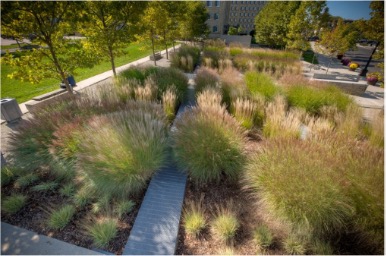
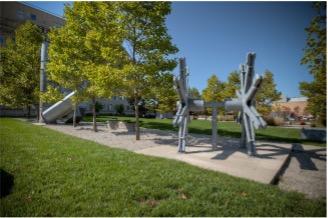
McNeill Jeff and Sellar Peter. “Barrel Warehouse Park”. Janet Rosenberg & Studio, https://jrstudio.ca/project/barrel-warehouse-park
ASSESSMENT AND MEASUREMENT
The adaptive reuse of the Seagram Barrel Warehouses meets some of the United Nations Sustainable Goals (SDGs) namely, SDG 11: Sustainable Cities and Communities and SDG 12: Responsible Consumption and Production (United Nations).


United Nations Sustainable Development Goals #11 and #12. Retrieved from: https://sdgs.un.org/goals
| SUSTAINABLE DEVELOPMENT GOAL 11: Sustainable Cities and Communities Make cities and human settlements inclusive, safe, reliant and sustainable. | ||
| TARGET | DESCRIPTION | APPLICATION TO PROJECT |
| 11.4 | Strengthen efforts to protect and safeguard the world’s cultural and natural heritage. | Instead of slating the former warehouses for complete demolition, the City of Waterloo chose to purchase the property and adapt the buildings into residential spaces in the downtown area of the city. |
| 11.7 | By 2030, provide universal access to safe, inclusive and accessible, green and public spaces, in particular for women and children, older persons and persons with disabilities. | In addition to the Barrel Warehouse Park adjacent from the lofts, the buildings feature rooftop gardens providing accessible community green spaces. |
| SUSTAINABLE DEVELOPMENT GOAL 12: Responsible Consumption and Production Ensure sustainable consumption and production patterns. | ||
| TARGET | DESCRIPTION | APPLICATION TO PROJECT |
| 12.5 | By 2030, substantially reduce waste generation through prevention, reduction, recycling and reuse. | In order to add to the character of the lofts, original bricks and timber were salvaged and incorporated into elements of the development. The extensive repurposing of materials involved time sensitive and selective demolition. Such reuse reduced demolition waste that would have ended up in the landfill. |
Feature image of Seagram Building facade detail, 2010, by Mark Falardeau on Wikimedia Commons
WORKS CITED
Books/Book chapters/Journal articles
- Beattie, Samantha. “Seagram Barrel Warehouse Receives Heritage Protection.” Waterloo Chronicle, 24 Nov. 2016.
- Desmond, Paige. “Waterloo Designates Seagram Lofts Under Heritage Act.” The Waterloo Region Record.” The Record, 21 Nov. 2016.
- Greene, Michele. “Developer Planning to Roll Out the Barrels: [1 Edition].” Toronto Star, Jul 25, 1998, pp. 1.
- Herman, Glenn. “Tools of the Trade.” Landscape Architecture, vol. 95, no. 11, 2005, pp. 32–38.
Policies and reports
- Canada Mortgage and Housing Corporation. “Residential Intensification Case Studies – Seagram Lofts.”
- City of Waterloo. “Commercial, Industrial and Retail Landscapes.” City of Waterloo,
- The City of Waterloo. “Designation of 3 and 5 Father David Bauer Drive, Waterloo.” 20 Mar. 2017.
Websites
- Janet Rosenberg & Studio.“Barrel Warehouse Park” Janet Rosenberg & Studio.
- Kiwi Newton. “Seagrams Loft | Kiwi Projects.” Kiwi Newton, . Accessed 17 Oct. 2024.
- “Land Acknowledgement – Independent Living Waterloo Region.” Independent Living Waterloo Region.
- “Seagram Cultural Heritage Landscape.” Waterloo.ca, 2020,
- United Nations. “The 17 Sustainable Development Goals.” United Nations, 2015.
- Waterloo Heritage. “A View to the Past: Views of the Seagram Lofts over Time.” Foundations: Waterloo Heritage News, 5 Apr. 2017.
- —. “The Adaptive Re-Use of Seagram Barrel Warehouses.” Foundations: Waterloo Heritage News, 1 July 2013.